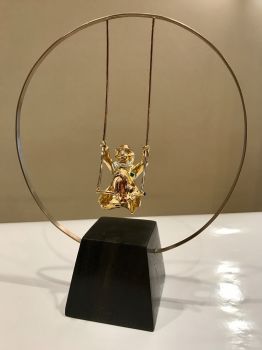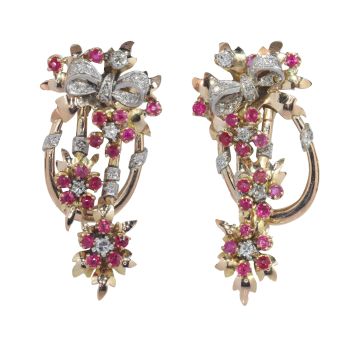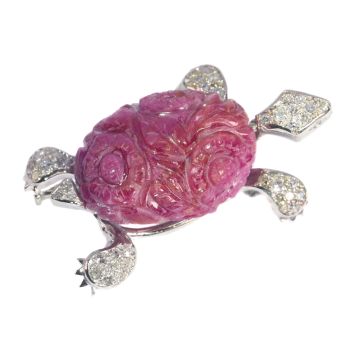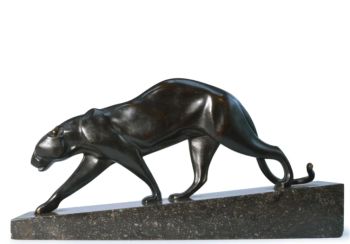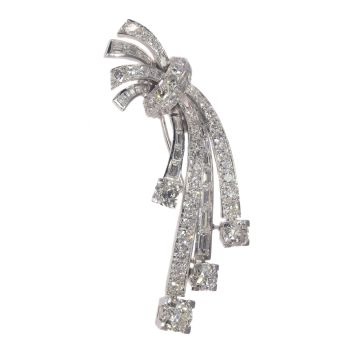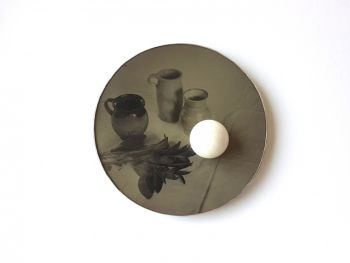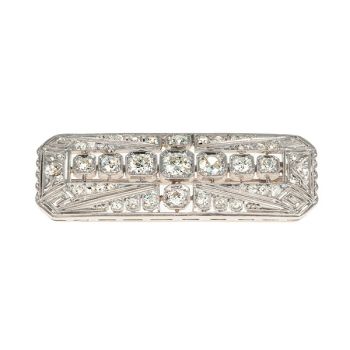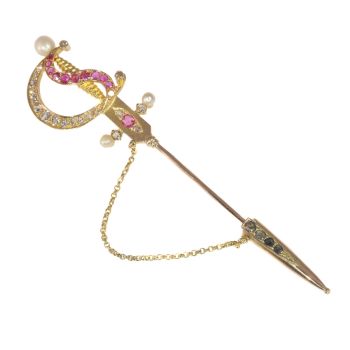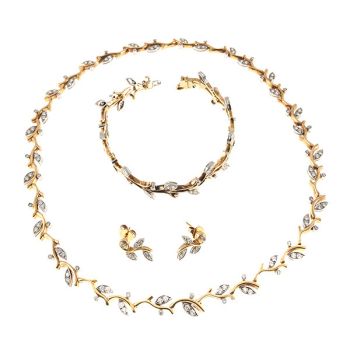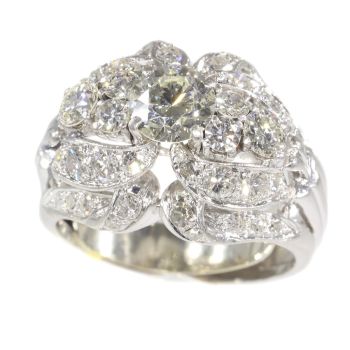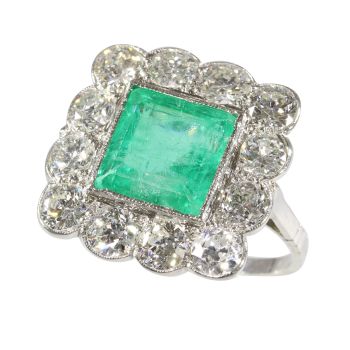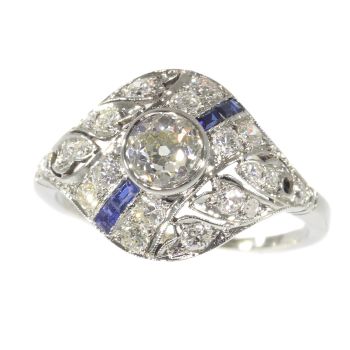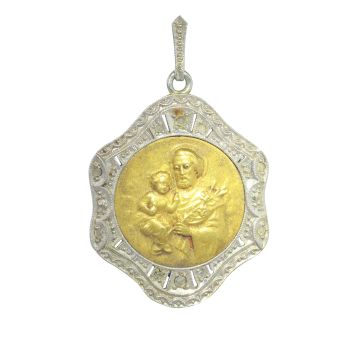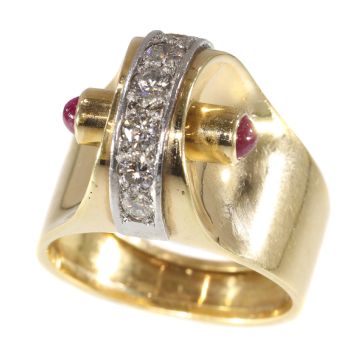Glamour Revisited: The 1950s Art Deco Diamond Brooch 1950
Onbekende Kunstenaar
Adin Fine Antique Jewellery
- Over kunstwerk
A resplendent vintage 1950s Art Deco brooch, masterfully crafted in platinum, encapsulates the opulence of its era. Centred by a brilliant old cut diamond of approximately 0.75ct and surrounded by 138 old mine cut diamonds totalling around 7.51ct, thispiece exudes luxury. Despite often being mistaken by experts for earlier Art Deco work, it is a genuine exemplar of 1950s style—no mere reproduction, but a continuation of Art Deco's legacy into the mid-twentieth century. Recently, its appeal hasbroadened, with gentlemen as well as ladies adorning their lapels with such statement pieces, showcasing a sophisticated blend of wonder, luxury, and delight. This brooch not only decorates but also declares a personal style and a nod to the glamorouspast.
Antique jewelry object group
brooch
Condition
very good condition
more info on our condition scale
Country of origin
unknown
Style
Vintage Fifties (of the twentieth century)
See also: Fifties (of the twentieth century)
more info on styles
Style specifics
This type of jewelry is very specific for the fifties of the twentieth century. The Art Deco period preceded only 20 years and was still used as source of inspiration, it is (even for the trained eye) sometimes very hard to note the difference betweenArt Deco and Fifties.
Period
ca. 1950
Events & facts of this era, poetry of this era, fashion of this era.
Material
platinum (touchstone tested)
more info on precious metals
Diamonds
One old brilliant cut diamond with an estimated weight of ± 0.75ct
138 old mine brilliant cut diamonds with an estimated weight of ± 6.76ct
Total diamond count
139 pcs.
Total diamond weight without rose cuts
approx. 7.51 crtwith an average colour and clarity G/I, vs/si
All diamond weights, color grades and clarity are approximate since stones are not removed from their mounts to preserve the integrity of the setting.
All diamonds we offer are screened by the I.J.G.C. for whether they are natural or synthetic, and all diamonds in this jewel are 100% guaranteed to be natural.
Birthstones
Diamond is the birthstone (or month stone) for April.
more info on birthstones
Hallmarks
No trace.
more info on hallmarks
Dimensions
5,80 cm (2,28 inch) x 3,25 cm (1,28 inch)
see picture with a ruler in millimeters and inches
Weight
15,90 gram (10,22 dwt)
Adin Reference Nº
24110-0138
Copyright photography
Adin, fine antique jewellery
Additional information
our latest acquisitions
jewelry glossary
wall of fame
visit us in Antwerp
subscribe to our mailinglist
- Over kunstenaar
Het kan voorkomen dat een kunstenaar of maker onbekend is.
Voor sommige werken is het niet te bepalen door wie het gemaakt is of dat het is gemaakt door (een groep) ambachtslieden. Voorbeelden zijn beelden uit de Oudheid, meubels, spiegels of handtekeningen die vaak niet duidelijk of leesbaar zijn. Maar ook sommige werken zijn helemaal niet gesigneerd.
Ook kunt u de volgende beschrijving vinden:
•"Toegeschreven aan …." waarschijnlijk een werk van de kunstenaar maar niet zeker of gedeeltelijk
•“Atelier van ….” of werkplaats van” een werk uitgevoerd in het atelier of atelier van de kunstenaar, eventueel onder zijn toezicht
•“Cirkel van ….” een werk uit de periode van de kunstenaar die zijn invloed laat zien, nauw verbonden met de kunstenaar maar niet noodzakelijkerwijs zijn leerling
•“Stijl van ….” of “Volger van ….” een werk uitgevoerd in de stijl van de kunstenaar, maar niet noodzakelijk door een leerling; kan eigentijds of bijna eigentijds zijn
•“Wijze van ….” een werk in de stijl van de kunstenaar maar van latere datum
•"Na …." een kopie (van welke datum dan ook) van een werk van de kunstenaar
•“Getekend…”, “Gedateerd….” of “Ingeschreven” dan is het werk gesigneerd/ gedateerd/ ingeschreven door de kunstenaar. De toevoeging van een vraagteken duidt op een element van twijfel
•"Met handtekening ...", "Met datum ...", "Met opschrift..." of “Draagt signatuur/datum/opschrift” dan is de handtekening/datum/opschrift toegevoegd door iemand anders dan de kunstenaar
Bent u geïnteresseerd om dit kunstwerk te kopen?
Artwork details
Related artworks
- 1 - 4 / 12
- 1 - 4 / 24
- 1 - 4 / 24
- 1 - 4 / 24
- 1 - 4 / 12











